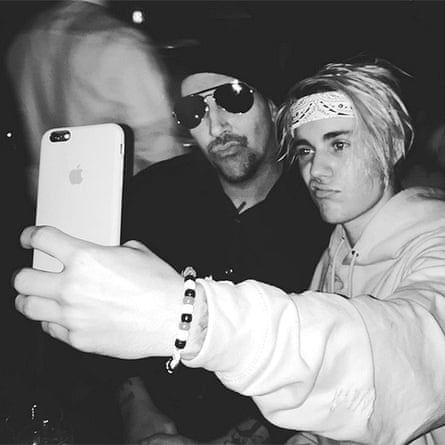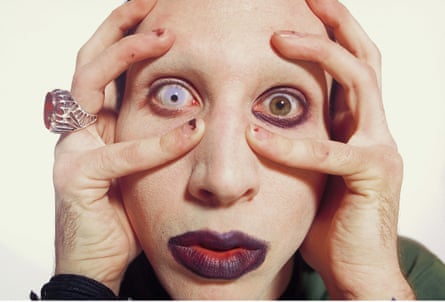Since Brian Hugh Warner created the character of Marilyn Manson in the early 90s, his powdered-up, red-lipped, asymmetrical alien face has been a constant presence in rock. But despite a lack of reinvention over the past two decades, his status in culture has entirely changed. Last year, Manson told the Guardian that he created a fake world for himself because he didn’t like the one that he lived in. He may still not like this world but, increasingly, the world likes him.
His most recent album, 2015’s The Pale Emperor, was hailed his best in a decade and debuted at No 8 on the Billboard 200. He collected “idol” accolades at rock magazine awards shows. Then, in a move no one could have predicted, pop’s biggest star, Justin Bieber, started wearing his T-shirts. “It’s upsetting when you loan someone a shirt after sodomy and they don’t return it,” was Manson’s response.
This article includes content provided by Instagram. We ask for your permission before anything is loaded, as they may be using cookies and other technologies. To view this content, click 'Allow and continue'.
This incongruous exchange continued. First, Manson posted an image of his album Mechanical Animals retitled The Douche Show with Bieber’s face over his own. In an absurd turn of events, he then signed off on Bieber repurposing his gothic merch as his own: a vest with Manson’s face on the front and “Bigger Than Satan” emblazoned on the back. Manson has since gone on to wear a T-shirt with the words Bigger Than Bieber on it, and the pair have even shared a selfie.

This was probably just an effort on Bieber’s part to appear edgy by aligning himself with a cult rock figure (as he has previously with the Misfits, Wu-Tang Clan and Metallica), but it seems his fan base is responding to this unlikely new direction. The T-shirt has become the best-selling item of merchandising on his Purpose tour. When Manson’s new album Say 10 (which sounds like Satan, of course) comes out next year, millions of young minds are likely to be warped.
A legion of Beliebers is a far cry from Manson’s formative fanbase. In his band’s early days in Florida, their shows attracted a very niche following of outsiders, dissenters and metalheads. The gigs were performance art heavy, with gory props and girls in cages or pulled on leashes. Manson quickly became the number one enemy of religious groups and, in an effort to get his shows banned, the Christian right claimed that those attending his performances would see homosexual acts, drugs and rape onstage. After the Columbine High School massacre in 1999, fingers pointed at Manson. It was falsely reported that the killers had been fans and were influenced by his music, making Manson a scapegoat and a bastion of toxic values. The association lingered.

But it isn’t only controversy that has allowed Manson’s reputation to endure. The many myths that charge his celebrity are key. Even in the information age, we can’t fully separate fact from fiction, and although rumours are discredited, an aura of mystery remains. Did he really get ribs removed to be able to give himself a blowjob? Did he get breast implants? Did animals die at his shows? Anything seems possible. Reading any one of his interviews from the past 25 years is like dipping into an essay dripping with philosophising, film references and filth, and there’s always a new facet added to his story: the self-styled God of Fuck only has sex in the dark and with his underwear on; his mum had Munchausen by proxy syndrome; he loves watercolour painting because it calms him.
Notwithstanding Bieber’s endorsement, Manson’s music has never been more relevant at a time of cultural and political turbulence. In 2015’s Killing Strangers, he sang: “We’re killing strangers so we don’t kill the ones that we love,” summarising the cycle of stupidity that is America’s gun crime problem. Whether it’s sexual abuse, religious hypocrisy or consumerism, Manson remains a relevant cultural figure rather than a 90s one, because he continues to address the times without lapsing into a parody. “We don’t like to kill our unborn / we need them to grow up and fight our wars,” he sang on We’re from America. And: “Some children died the other day / we fed machines and then we prayed / puked up and down in morbid faith / you should’ve seen the ratings that day,” on The Nobodies. In an interview with Dazed & Confused magazine last year, he said: “America has to stick their dick and their nose in every goddamn thing across the world and they somehow believe that it’s righteous or political when it’s simply financial.” What US syndrome will he turn to on Say 10? Gun crime? Police brutality? Republicans? The presidential campaign? As long as young people are angry (which they are), he will have listeners.
Back in 2014, Smashing Pumpkins’ Billy Corgan said of his friend and collaborator: “He’s very savvy in that he lets people think things about him or plays into things to see what will happen, almost like a performance artist. He’s a visionary in a way, because he identified a culture that was coming and now that culture is everywhere.” Manson’s performance art was there in those dirty, early shows, and in his responses to his many critics, and it’s just as alive now in the way he expands our ideas of him. He is a famed exhibitionist who has spent his career mutilating the culture of celebrity. Some might consider Manson’s knowing acceptance of Bieber’s fandom as another strand of his own carefully manipulated art. He has not sold out or softened with age. On Instagram, mid-selfie, Manson is engaging in his own meta-drama – just as he always has.

Comments (…)
Sign in or create your Guardian account to join the discussion